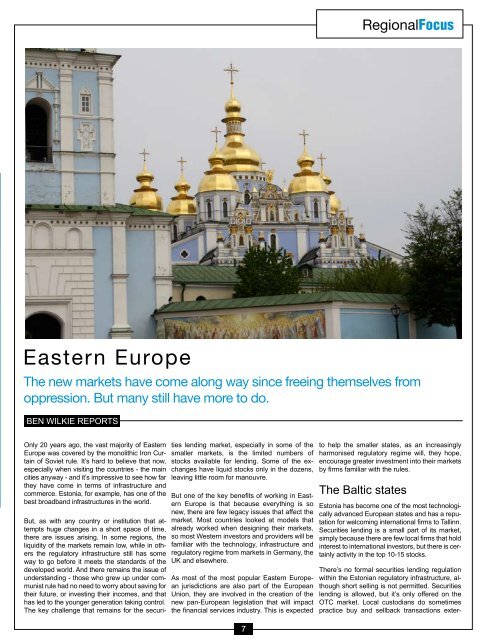read - Securities Lending Times
read - Securities Lending Times
read - Securities Lending Times
Create successful ePaper yourself
Turn your PDF publications into a flip-book with our unique Google optimized e-Paper software.
RegionalFocus<br />
Eastern Europe<br />
The new markets have come along way since freeing themselves from<br />
oppression. But many still have more to do.<br />
BEN WILKIE REPORTS<br />
Only 20 years ago, the vast majority of Eastern<br />
Europe was covered by the monolithic Iron Curtain<br />
of Soviet rule. It’s hard to believe that now,<br />
especially when visiting the countries - the main<br />
cities anyway - and it’s impressive to see how far<br />
they have come in terms of infrastructure and<br />
commerce. Estonia, for example, has one of the<br />
best broadband infrastructures in the world.<br />
But, as with any country or institution that attempts<br />
huge changes in a short space of time,<br />
there are issues arising. In some regions, the<br />
liquidity of the markets remain low, while in others<br />
the regulatory infrastructure still has some<br />
way to go before it meets the standards of the<br />
developed world. And there remains the issue of<br />
understanding - those who grew up under communist<br />
rule had no need to worry about saving for<br />
their future, or investing their incomes, and that<br />
has led to the younger generation taking control.<br />
The key challenge that remains for the securities<br />
lending market, especially in some of the<br />
smaller markets, is the limited numbers of<br />
stocks available for lending. Some of the exchanges<br />
have liquid stocks only in the dozens,<br />
leaving little room for manouvre.<br />
But one of the key benefits of working in Eastern<br />
Europe is that because everything is so<br />
new, there are few legacy issues that affect the<br />
market. Most countries looked at models that<br />
al<strong>read</strong>y worked when designing their markets,<br />
so most Western investors and providers will be<br />
familiar with the technology, infrastructure and<br />
regulatory regime from markets in Germany, the<br />
UK and elsewhere.<br />
As most of the most popular Eastern European<br />
jurisdictions are also part of the European<br />
Union, they are involved in the creation of the<br />
new pan-European legislation that will impact<br />
the financial services industry. This is expected<br />
7<br />
to help the smaller states, as an increasingly<br />
harmonised regulatory regime will, they hope,<br />
encourage greater investment into their markets<br />
by firms familiar with the rules.<br />
The Baltic states<br />
Estonia has become one of the most technologically<br />
advanced European states and has a reputation<br />
for welcoming international firms to Tallinn.<br />
<strong>Securities</strong> lending is a small part of its market,<br />
simply because there are few local firms that hold<br />
interest to international investors, but there is certainly<br />
activity in the top 10-15 stocks.<br />
There’s no formal securities lending regulation<br />
within the Estonian regulatory infrastructure, although<br />
short selling is not permitted. <strong>Securities</strong><br />
lending is allowed, but it’s only offered on the<br />
OTC market. Local custodians do sometimes<br />
practice buy and sellback transactions exter-












